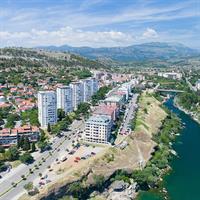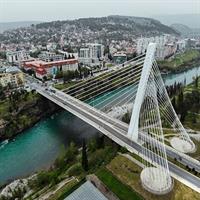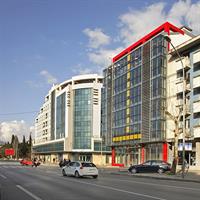EXPERIENCE PODGORICA



Overview
Podgorica is the capital city of Montenegro and the largest city in the country with a population of over 200,000 people. Nestled between the Dinaric Alps, and Lake Scutari in the heart of the country, the city is crossed by several rivers: the Moraca and Ribnica flow right through the city.
The city features a mixture of architectural styles that reflect its turbulent past, as one regime replaced another, a corresponding style was introduced. The oldest parts of the city are Old Town or Stara Varos where the only remnants of the city’s Ottoman architecture remain and where the city’s two mosques, and the Turkish clock tower stand.
New Town or Nova Varos is now the traditional city center on the banks of the Ribnica River with a noticeable European influence with wide streets that extended the orthogonal street layout of the city center from south to west. The city was bombed over 70 times and reduced to rubble during World War II, after liberation mass residential blocks were erected around the city with the basic design which is typical of Eastern bloc countries.
Since the 1990’s the architecture of the city has progressed rapidly incorporating an interesting mixture of old and new with residential and business construction with contemporary glass and steel architecture trends. The city has gained new squares, and monuments with some of the new landmarks including Hristovog Vaskrsenja orthodox temple, the magnificent Millenium Bridge which is the star on Podgorica’s skyline.
Podgorica is a great gateway and base for visiting the surrounding Montenegrin coastal cities such as medieval Kotor and the mountainous regions with ski resorts and national parks, all within an hour's drive, making these destinations easy to reach for day trips.
Visitors can discover the true Montenegro in the city with something different and undiscovered around every corner. The city boasts a charming cafe culture, a vibrant nightlife, sprawling parks, and winding rivers with broad tree-lined streets brimming with restaurants, cafes, shops, pubs, bars, and more, making it one of Europe’s most frequented capital cities.







Things to see and do
Some of the best ways to get acquainted with the city are to wander around the old and new neighborhoods such as Old Town, and New Town stopping into one of the many charming cafes for a cappuccino or espresso and a freshly baked pastry. Unique and authentic shops and boutiques line the narrow streets of Old Town and the tree lined streets of New Town, pick up traditional souvenirs and handcrafted goods. Wandering through the many beautiful spacious parks in the city is a great way to get to many of the points of interests and leads to the two rivers; Ribnica and Moraca
Republic Square is the largest square in Montenegro covering 15,000 square meters with a beautiful fountain in the center, which is beautifully illuminated at night. Charming alleyways stretch out from the core lined by palm and oak trees and decorated by traditional buildings where the National Library of Montenegro and the Town Hall stand.
Some of the best ways to get acquainted with the city are to wander around the old and new neighborhoods such as Old Town, and New Town stopping into one of the many charming cafes for a cappuccino or espresso and a freshly baked pastry. Unique and authentic shops and boutiques line the narrow streets of Old Town and the tree lined streets of New Town, pick up traditional souvenirs and handcrafted goods. Wandering through the many beautiful spacious parks in the city is a great way to get to many of the points of interests and leads to the two rivers; Ribnica and Moraca
Stroll through Independence Square, formerly Republic Square is the largest square in the country found in the heart of the city of Podgorica. It is the central town square of the city located in Nova Varos, or New Town covering 15,000 square meters, it is the socio-cultural heart of the city decorated by wonderful alleys lined with palms and oaks. The center of the square features a beautiful fountain which is charming at night when it is illuminated by lights. The state gallery “Art” and the city library are located on the square, and the square connects to pedestrian streets for shopping and dining options.
Visit Lake Skadar is nested on the border of Albania and Montenegro, it is the largest lake in Southern Europe named after the city of Shkoder in Northern Albania. The dolphin-shaped karst lake has its tail and two-thirds of its body in Montenegro, and its nose in Albania. The portion on the Montenegrin side has been protected by a national park since 1983. The area around the lake encompasses soaring mountains, clear waters, island monasteries, and floating meadows of water lilies, and dotted with tiny and charming lakeside towns such as Virpazar, and Vranjina.
The Cathedral of the Resurrection of Christ is located in the New Town neighborhood of Podgorica, west of the Moraca river. It is a cathedral of the Metropolitanate of Montenegro and the Littoral of the Servian Orthodox Church. The cathedral took over 20 years to build and sits in a striking, and unusual building with high shite stone towers, gold crosses, intricately carved marble, and ancient stone walls. The interior is even more striking with huge chandeliers, gilded frescoes including one controversial image above the front door showing Karl Marx burning in hell. The temple's twin towers measure at 88 feet high, and 17 bells are situated in the loft, one of which weighs around 11 tons, making it the largest bell in the Balkans.
Visit the Plantaze Winery, the largest unbroken vineyard in all of Europe. The winery offers guides, with a ride through the vineyards on a tourist train, tours of the Sipcanik wine cellar, and tastings. They also have horseback riding on site.
See the iconic Millennium Bridge is a cable bridge that spans the Moraca River and connects Old Town, and the New Town in the city of Podgorica, Montenegro. The bridge is 567 feet long and the pylons soar 187 feet above the road with 12 cables supporting the roadway. The bridge opened in 2005, on Montenegro’s National Day July 13th, it was designed by the Slovenian company Ponting and Mladen Ulicevic. The roadway carries two lanes of traffic in each direction, and a pedestrian walkway travels in both directions. The bridge features an unusual, unique appearance and is particularly beautiful at night when illuminated by lights.
King’s Park is situated in the heart of the city, an urban park established in 1910 marking the coronation of Nicholas I of Montenegro. A verdant oasis situated in the center of Podgorica featuring a covered pavilion topped with red Spanish tile, a fountain, benches, playground equipment, and wifi. The park is a cozy green space in the city, the perfect place for a picnic, or a game of chess, it is one of the nicest parks in the city. There are several interesting statues and sculptures dotted around the park dedicated to important Montenegrin social figures, including Husein Dzavid the poet.
The Ribnica River is a small river that runs through the capital city of Podgorica, it winds its way through the northern part of the old town and Park Forest Gorica, the largest park in the city. The Ribnica is a tributary to the Moraca River, they meet at the center of the city, an area of the city “Vrela Ribnicka” is named after the river. The Old Ribnica Bridge is an ancient Roman bridge crossing the river at its mouth where it meets the Moraca.
The Clock Tower or Sahat Kula stands tall in the city of Podgorica in the heart of the Old Town historic district. The clock tower is the only remaining relic from the Ottoman Empire era and stands 52 feet tall, an iconic monument and testament to Islamic architecture, it's over 300 years old. The clock tower managed to survive the bombings of World War II, the main feature of the town is the large clock fixed to the facade that has been working since it was built.


Shopping
Podgorica offers the visitor plenty of great shopping opportunities from vibrant markets, unique boutiques, and large shopping malls, there’s something for everyone. There are dozens of little stores (Butik) dotted around the capital city, there are quite a few streets such as Ulice Slobode, Ulice Vucedolska, and Hercegovacka in the city filled with quaint boutiques and other shops. The Mall of Montenegro is located by the train and bus stations, it is the smallest of the three malls in the city and has stores offering brand name clothing, shoes, and accessories. Inside the circular building, there are local and international brands, a pool hall, and a fresh produce market.
Delta City is the largest and newest shopping mall located in “City Kvart” to the east of “New Town”, there are 98 different stores in the mall along with restaurants and other services. Two levels include European clothing chain stores, a cinema, cafes, and kid's play area.
The city has plenty of exquisite books stores, CD stores, and shops selling modern ski gear especially Elan’s representative shop.
The Big Green Market, is a great growing market mall offering a variety of fruits and vegetables, domestic cheeses, fresh fish, and lots of other delicious local foods.






Dining and Nightlife
The cuisine of Montenegro combines wonderful flavors and specialty dishes including hearty meat dishes, garlicky seafood, mountain fare, and traditional dishes. The cuisine is a mixture of different countries including Albanian, Greek, Turkish, Spanish, and Italian leaving visitors with a variety of options on the menu when visiting the country. The capital city of Podgorica boasts an abundance of fantastic restaurants dotted all around the city, there are plenty of options to choose from including pizza’s, pasta’s, stew’s, fresh meats and cheese, cafes with delicious cappuccinos, espressos and snacks, and wonderful bakeries serving up freshly baked goods.
Some traditional dishes that can be found in Podgorica include smoked Njeguski prosciutto ham from the Njegusi village. The climate and altitude in the village create the perfect combination and conditions for making mouth-watering prosciutto. Njeguski Steak is another favorite made of veal or pork schnitzel and filled with Njegusi prosciutto and cheese.
Buzara is a local staple that is made up of shrimps and prawns cooked in either red or white sauce made with wine, onions, tomatoes, herbs, and spices. A great dish to gather together with family and friends.
Ispod Saca is the Balkan’s version of a Sunday Roast, served with either slow-roast lamb, veal, or goat served with potatoes, carrots, onions cooked under a metal dome covered with coals. The meat falls off the bone and is super tender and delicious with succulent vegetables.
Montenegrin lamb cooked in milk is another traditional dish. The lamb meat is slowly stewed in milk with potatoes, carrots, fennel, rosemary, garlic, parsley, and other seasonings, made in a sack over coals.
Cevabdzinicas is a noticeable establishment found on every corner in the city selling cevapi, small sausages that are made of minced beef or pork and served with a salad.
Burek is a popular Balkan breakfast staple in the city made of filo pastry and filled with cheese, meat, spinach, or potatoes. It comes in spirals, wedges, and tubes with an oily, crunchy texture and a mouth-watering filling.
Travel to Skadar Lake, where the enormous lake and a national park are located, and enjoy the region’s specialty, lake carp, served fried, smoked, or marinated in oil.
There are lots of fine restaurants, and cafes located in the city of Podgorica, many can be found located in the traditional city center, around Roman Square, and along with the SV. Petra Cetinjskog Blvd which connects the two. Dozens of cafes are dotted around the city especially along the pedestrian street of Njegoseva Street in the heart of the city, and there are newer, trendier cafes opening around the “Vectra” business district. The cafes in Podgorica are cozy with outdoor seating, the perfect places to sit back, relax, and sip on an espresso or cappuccino. Some of the city’s well-known cafes include; Alpe bar, Buddha bar, Grand cafe, Cafe, Cafe, and Soul II Soul. The city boasts dozens of pizzerias serving delicious pizza. Hamburgers are the most popular fast food item in the city, but there are no westernized fast-food chains in the city.
Pod Volat is undoubtedly one of the most popular restaurants in the city, located next to the clock tower where locals and tourists come to enjoy massive servings of delicious authentic Balkan food. Pod Volat is the city’s most highly rated eatery open daily from 7 am until 12 am offering a large menu with plenty of options and huge portions and great prices.
Dali is a stylish and contemporary restaurant nestled in the heart of downtown Podgorica featuring a rich interior dining area decorated with purple velvet chairs, ruby silk curtains, and soft leather sofas. The restaurant's exterior boasts a modern, minimalist garden, great for enjoying the Mediterranean outdoors and atmosphere. The restaurant serves breakfast, lunch, and dinner with a mixture of Italian and Orientation cuisine including pasta, risottos, seafood, and salads. Native Montenegrin wines from Plantaze vineyard grace the wine list.
Per Sempre is an elegant, upmarket eatery serving delicious authentic Italian cuisine. The establishment is decorated with Renaissance-style artwork with a wooden interior and a grand piano. Italian classics are featured on the menu including spaghetti carbonara, and penne Pomodoro. There is a charming outside terrace where diners can enjoy the laid back ambiance on warm Montenegrin evenings.
There is quite a vibrant nightlife scene on offer in Podgorica with clubs, cafes, and bars buzzing with people and a great atmosphere every night. Things get pretty crowded along Bokeska and Njegoseva Streets, two of the busiest streets in the city, especially at night when they are brimming with tons of cool bars, posh restaurants, authentic pubs, and happening clubs. During the summertime, there are many open-air bars and clubs on offer in the city, with live music offered and a great ambiance.
The national drink of Montenegro is Rakija with a whopping 40% alcohol content it packs quite the punch! The liquor is typically homegrown and sometimes reaches 80%. It is a fun Montenegrin tradition.



History, Culture, and Festivals
Podgorica has been continuously inhabited since the Illyrian and Roman eras, the site of today’s Podgorica was firmly established during Ottoman Empire rule. The city was reincorporated in Montenegro in 1878, It was pretty much wiped out by bombing during World War II and much of the Ottoman and Montenegrin era architecture was destroyed. Podgorica was reborn as the capital city in Socialist Yugoslavia (SFRY), it was then expanded and rebuilt in a typical Eastern Bloc countries manner at the time. Since the break up of Communist Yugoslavia, the cityscape has changed a lot and received a lot of development including new modern buildings, and landmarks which create a great blend of old and new. There is a large amount of Turkish Ottoman architecture in Podgorica that can still be seen in the oldest neighborhood in the city, Old Town, or Stara Varos with its winding Turkish streets, two mosques, and the Turkish Clock Tower.
Montenegro’s capital city is home to many of the country’s cultural institutions and events including the Montenegrin National Theatre and several fascinating museums, and vibrant galleries such as the City Theatre which includes the Children’s Theatre, and the Puppet Theatre. Noteworthy museums in Podgorica including The Podgorica City Museum which preserves the city’s rich heritage and features four categories; historical, cultural-historical, archeological, and ethnographic. The Natural History Museum features interesting displays of Montenegrin flora and fauna specimens.
The city is the host of a range of cultural events that take place over the summer, there are open-air movie nights, outdoor concerts, poet nights, folklore shows, ballet dancing performances, fine arts exhibitions, and numerous theatres pieces found all over the city.
FIAT is the Festival of the International alternative theaters where theatre festival troupes gather from southeast Europe. Acclaimed to be one of the best festivals of alternative theatre in Europe, FIAT has put Becket, Shakespeare, and others onto the stage in a unique way.
The festival of Podgorica Cultural Summer is celebrated during the summertime and includes various traditional and cultural performances.
December Arts Scene is observed for the entire month with music, literature, theatre, and art scenes.
The Podgorica Film Festival has been held for 5 years now (2020) on the first VoD platform in Montenegro.